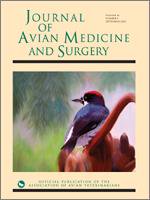The hyacinth macaw (Anodorhyncus hyacinthinus), considered the largest psittacine bird species in the world, is an endangered species, with a remaining population of approximately 6500 birds in the wild. To establish hematologic and plasma biochemical reference ranges and to verify differences related to sex, samples from 29 hyacinth macaws (14 males, 15 females) were obtained from birds apprehended from illegal wildlife trade and subsequently housed at the Sorocaba Zoo, Brazil. No significant differences in hematologic or plasma biochemical values were found between females and males. Compared with published reference values, differences were found in mean concentrations of total red blood cell count, corpuscular volume, corpuscular hemoglobin level, total white blood cell count, aspartate aminotransferase level, creatine kinase concentration, alkaline phosphatase concentration, and phosphorus level. Baseline hematologic and plasma biochemical ranges were established, which may be useful as reference values for clinicians working with this endangered species in captivity or rehabilitation centers.
How to translate text using browser tools
1 September 2012
Hematologic and Plasma Biochemical Values of Hyacinth Macaws ( Anodorhynchus hyacinthinus)
Cristiane K. M. Kolesnikovas,
Claudia Niemeyer,
Rodrigo H. F. Teixeira,
Adauto L. V. Nunes,
Luciana C. Rameh-de-Albuquerque,
Sávio S. Sant'Anna,
José L. Catão-Dias
ACCESS THE FULL ARTICLE
Anodorhyncus hyacinthinus
Avian
hematology
hyacinth macaw
plasma biochemical analysis





